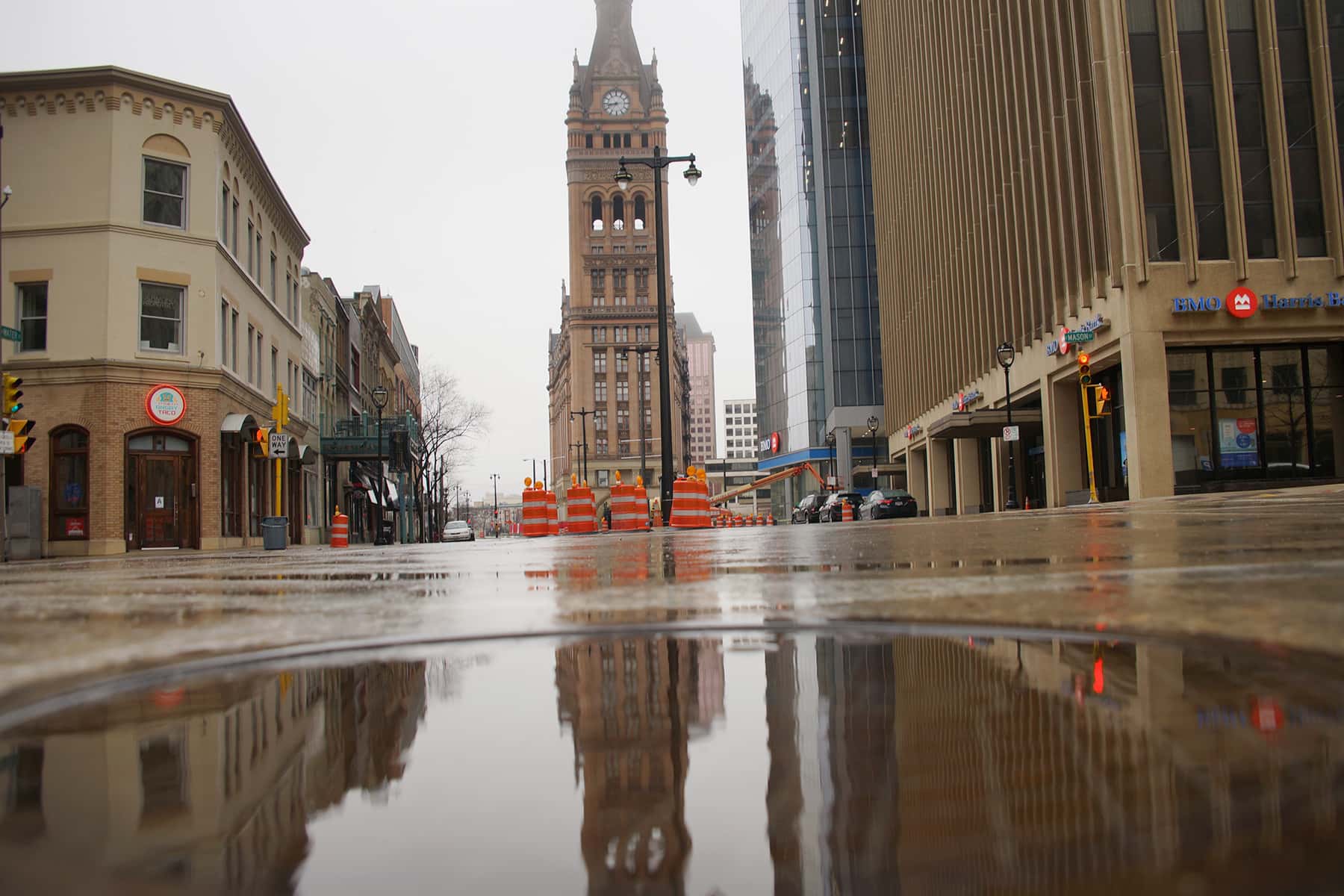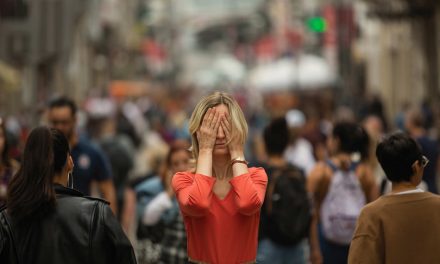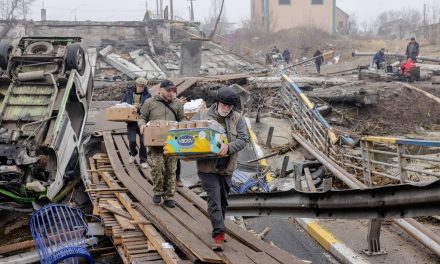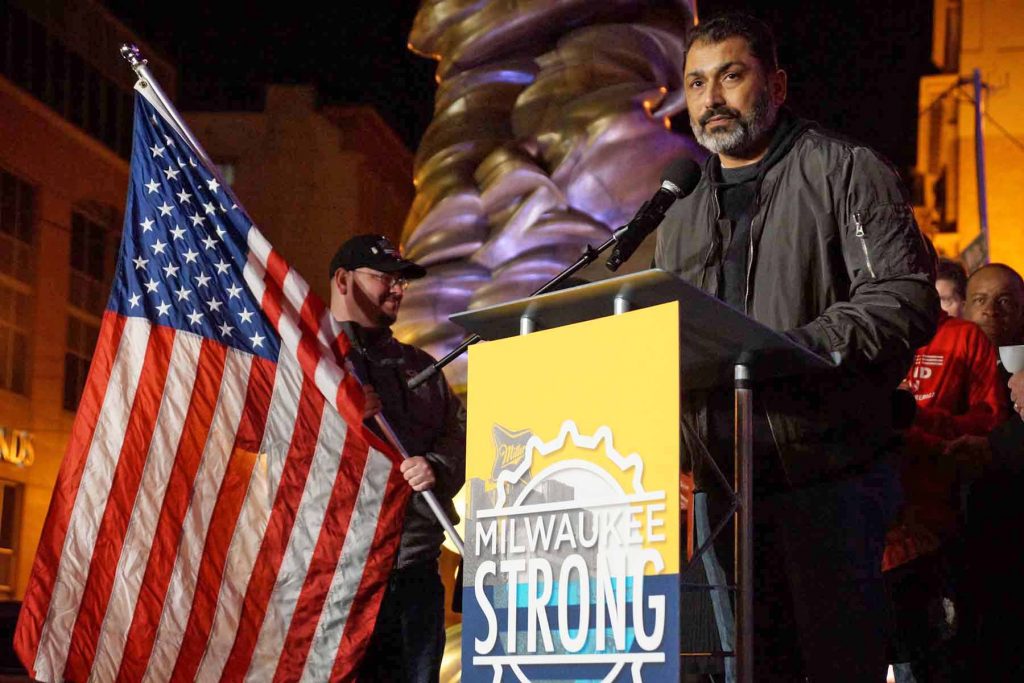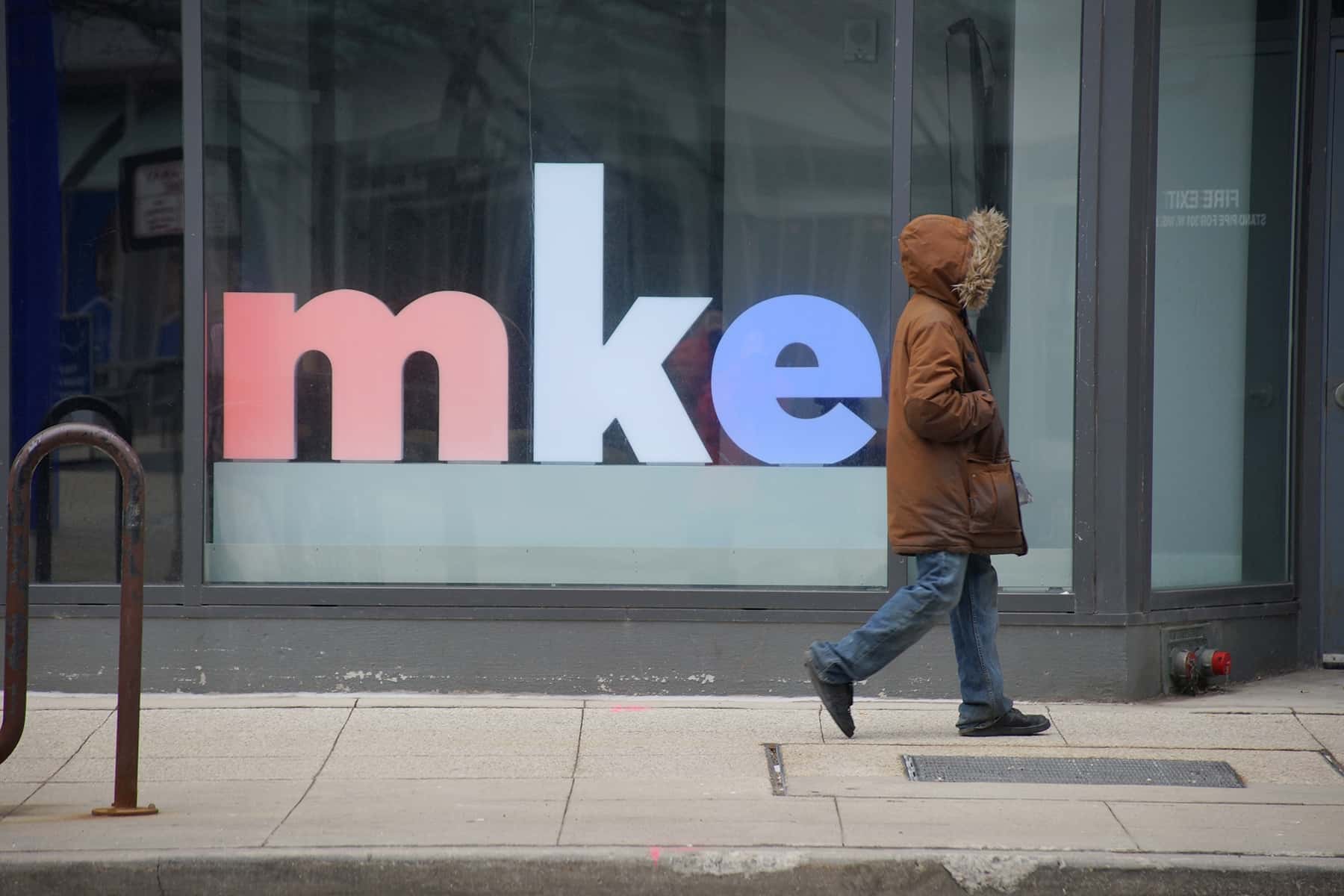
Like many of you, I’ve had a lot of time to read: Brené Brown’s Dare to Lead, Charles Eisenstein’s “The Coronation,” Google searches on “fight or flight.” I’ve been asking myself: What do COVID-19, Brown, Eisenstein and Selye have in common? What is the sweet spot of this curious Venn diagram? My answer: The hypothalamic pituitary adrenal axis and the creative mode of our brains. Obvious, right? What would have been obvious and expected is writing about this month’s ArtWorks for Milwaukee Gallery Night exhibit or next month’s Janes Walk MKE or a summer of urban gardening and mentoring with Teens Grow Greens, projects that I, my interns and my colleagues had spent months preparing for. But things have changed. So I’ve found myself researching my body, your body, our collective body – and have discovered some interesting things. My hope is that the global release of adrenaline and oxytocin, and the collective activation of our brain’s imagination networks, will help create a better world. That the best parts of our “new normal” – not the protective masks and the physical distancing but the vulnerability, sacrifice, social connections and creativity – do indeed become a new normal.
For the past few months, while COVID-19 made its way around the world to the United States, I’ve been reading Brown’s book Dare to Lead with my Teens Grow Greens colleagues, and her language of vulnerability – or “the emotion that we experience during times of uncertainty, risk, and emotional exposure” – has taken on a strange new significance. It’s one thing for Brown to insist on being vulnerable at work and home but now we have no choice but to feel an unprecedented collective vulnerability. How have we responded – and why?
I keep wondering what was going through toilet paper hoarders minds? And how, with very little resistance, we have confined ourselves to our homes, donned face masks and embraced mass video chats. Even our language has changed: “social distancing”? I’ve been interested in not just what’s been going on in our heads – but what’s really been going on in our brains, on a hormonal and behavioral level. Is stuff happening in our brains right now that will change us irreparably – for good or for ill – in the long run?
I had to do a lot of research, and I still don’t understand half of it. I minored in Biology, but that was back in the early 90s. So if you had asked me a few weeks ago what the hypothalamus is, I’d have stared blankly. I definitely could not remember what the HPA axis is. It’s fascinating to think about what’s been happening inside us: in each of us, the communications between our hypothalamus, our pituitary gland and our adrenal glands has activated stress responses that are affecting our brain’s plasticity in good and bad ways. In a short period of time, we’ve all had to choose between not only the well-known “fight or flight” response that Selye identified in 1936 but also what’s called the “tend and befriend” approach. At the beginning of this crisis in the United States, we saw an embarrassing amount of the former; now, we stand in awe of the latter.
We stand in awe of people sacrificing so much so that others aren’t sacrificed to COVID-19: unusual (but why?) outpourings of generosity and joy, unusual (but why?) explosions of adaptivity and courage. I’ve learned in my research that our brains operate in two modes: creative and uncreative. Right now, unless we’re in the camp of folks who still thinks it’s a good idea to crowd beaches for Spring Break or have a cookout with friends and family or force Wisconsinites to vote during a quarantine, our brains have been in creative mode overdrive, making us ask with Eisenstein, “What world shall we create?”
STRESSED OUT AND NOWHERE TO GO
We’ve all encountered our share of mind and body stressors during this time, some more than others. The fact that we don’t know much about the virus. The term “rapidly developing situation.” The invisibility of viruses and the emptiness of our streets and businesses. Face masks and people tallying our arrival at the grocery store, the fear in people’s eyes when they bump our cart coming around a corner, the disinfecting of shopping carts. And we all have our own anxious quarantine stories.
Experiencing only these things is a new form of privilege. Millions have filed for unemployment, tens of thousands have lost loved ones. The fear that either of those could happen any day is palpable, especially among more vulnerable populations. For millions of people, the virus has added insult to existing injuries. Eisenstein lays it out: “Fear, along with addiction, depression, and a host of physical ills, flourishes in a terrain of separation and trauma: inherited trauma, childhood trauma, violence, war, abuse, neglect, shame, punishment, poverty.” The crisis has brought to the surface inequities and failings that are pre-existing conditions. The world pre-COVID-19 was already wounded. Eisenstein includes in his litany “the muted, normalized trauma that affects nearly everyone who lives in a monetary economy, undergoes modern school schooling, or lives without community or connection to place.”
The spread of this virus has been like the ripping off of a bandaid to reveal that we’ve too-long failed at solving big problems like hunger, homelessness, racism, global warming, failing schools. And we’ve too-long lived with imperfect systems that have neglected the most vulnerable. And sometimes we don’t care, which is why Wisconsin Republicans sent people to the polls this month.
What world shall we re-create? What should we abandon?
RELEASING OXYTOCIN INTO OUR BODIES & COMPASSION INTO THE WORLD
When we’re stressed, the hypothalamus in our brain talks to the nearby pituitary gland, which calls out to the adrenal glands all the way down on our kidneys, which then release multiple stress hormones that cause a sudden spike in blood sugar, heart rate and blood pressure.
Selye used the term “distress” to refer to “bad stress,” or stress-induced adaptations to our brain. Distress sent some of us in a frenzy to the grocery store to stock up on toilet paper and hand sanitizer. And it sent others into immediate self-quarantine; they didn’t need to wait for any “safer at home” orders to isolate themselves from something they couldn’t see.
We know, of course, that this negative distress can be detrimental to our health. Dopamine constricts our blood vessels and increases our blood pressure, which can lead to heart attack or stroke. Too much epinephrine, or adrenaline, can lead to diabetes or asthma. Too much cortisol can lead to obesity, heart disease and osteoporosis. The release of cortisol has also been linked to a greater susceptibility to catching a cold because it weakens the immune system. Definitely not a good thing during this time.
What I didn’t know is that Selye also used the term “eustress” to refer to “good stress” that makes compensatory adaptations to our brain. Instead of trying to kill the monster or hide in a cave, this equally biological (and mythic) response counteracts those options and gives us a sudden surge of confidence and control, with the hope of a reward. And it can be exhilarating. Eustress is the fifteen minutes before a race, cramming for a test, seeing someone in need and screeching your car to a halt to help.
Somewhere in between distress and eustress, I think, is Eisenstein’s explanation for why we’ve responded so quickly and efficiently to COVID-19 and not to those big world problems I mentioned above. In the face of hunger, homelessness and global warming, he says, “we as a society do not know what to do. Our go-to crisis responses, all of which are some version of control, aren’t very effective in addressing these conditions.” And so we flee from addressing them in systemic ways. “Now,” Eisenstein continues, “along comes a contagious epidemic, and finally we can spring into action. It is a crisis for which control works: quarantines, lockdowns, isolation, hand-washing; control of movement, control of information, control of our bodies.” Fight with a sense of control. Flatten the curve.
But those of us who aren’t calling the shots and having to make important large-scale decisions are complying with those decisions and exhibiting what Dr. Shelley Taylor calls “tend and befriend” behavior, a counterpart to Selye’s fight or flight distress. As we’ve seen during the past few months, stress can also stir us to nurture ourselves more than we normally do, to nurture others more than we normally do. It makes us better friends and helps us maintain and expand our social networks. It wakes us out of our selfishness and self-preservation and directs us toward others. Whatever you call it – eustress or tend and befriend – it’s us dropping off a package of toilet paper on someone’s front porch or clogging the Zoom network with video chats instead of hoarding or hiding.
So yes, stress can be bad for you. But it turns out it can also be good, especially in times like these.
I learned that in addition to releasing dopamine, adrenaline and cortisol, the adrenal glands also release the anti-stress hormone oxytocin. Psychologist Kelly McGonigal admits that she would always warn her clients that stress was detrimental to their health because of all those stress hormones being released. In a 2013 TEDX Talk, however, she reveals the findings of two studies that changed her perspective. In the first study, 30,000 adults in the United States were asked how much stress they’d experienced in the past year and whether or not they believed stress was harmful. The researchers followed the test subjects for eight years and recorded who died during that time. As McGonigal describes it, those who had high stress and believed stress was harmful had a higher risk of dying (43%) than those with low or moderate stress. However, those high-stress subjects who believed that stress wasn’t harmful had zero increased risk of dying. Those who had high stress and believed it was bad for them were more likely to die.
In the second study, researchers got a similar result: high-stress subjects had a 30% increased risk of death but those who were high-stress and also spent time caring for others had no increased risk. So what’s going on? Should we just deal with stress, think positive thoughts, and volunteer at a soup kitchen? Partly.
McGonigal believes that if we view our bodies’ physical responses to stress – rapid heartbeat, sweat, tension – as positive, as giving us what we need to get into the game or preserve ourselves, then we’ll be much healthier. We can harness the stress, “tend” to our own needs first – you know how flight attendants tell you to put your oxygen mask on first?. Then move beyond ourselves to “befriend” others and do good even for strangers. McGonigal explains our body’s clever homeostatic release of oxytocin when we’re stressed. The same hormone that is released during labor, during breastfeeding and after orgasm also helps counteract the potentially damaging effects of dopamine, adrenaline and cortisol, thereby lowering our blood pressure and increasing our pain thresholds. Oxytocin drives us to positive social interactions, drives us toward physical intimacy, increases our empathy and our willingness to help and support others. Like Brené Brown always says, “we are hardwired for connection.”
It’s this hardwiring that’s buzzing within us now as we decide every hour of every day how we’re going to respond to the stress and the fear of the invisible, the unknown. It’s waiting to be turned on. Like I said before, many of us are in much more dire situations than others – the most vulnerable and those putting themselves on the front lines – so it is even more important that we embrace our inner oxytocin for them and release compassion, kindness, and love into the world so that no one feels alone. How many times have we heard people saying “We’re all in this together”? To quote Brown again, vulnerability is “having the courage to show up when you can’t control the outcome.” Even more vulnerable is showing up for others.
What world shall we create?
ACTIVATING CREATIVE MODE
All around the world, including Milwaukee, we’ve seen people fighting the virus in ways that feel controllable, like shielding faces and washing hands, and fleeing the virus through physical distancing and isolation. But now that we’re not “busy” anymore, we have plenty of time to respond to the stress of the crisis with oxytocin-induced compassion and connection. There’s no excuse. The ways in which we’ve been creating and revising the ways we do things seems unprecedented: we’ve all become innovators. How can I share my art and writing, my dance and yoga, even a happy hour clink of the glasses? What mental health resources does my community need? How will my school do virtual learning all of a sudden- – and who needs computers and wifi? How to sustain business and feed the community with curbside pick-up or hundreds of free meal kits for the most vulnerable? How can I continue to exercise and enjoy the fresh air and still maintain physical distance? How can I create spontaneous joy and hope for passersby with chalk drawing, messages, and hopscotch?
In other words, what can we create that can help ourselves and other – and how can we stay connected – with or without the virus?
I’ve found myself working with Jane’s Walk MKE to rethink how residents can still explore the city while being physically distant (ironically, the inspiration book for this year was Priya Parker’s The Art of Gathering: How We Meet and Why It Matters – we’ve all had to rethink how we “gather”). I’ve worked with ArtWorks for Milwaukee to create an artistic response to the crisis, a new project called Abundance MKE, the name taken from another phrase few of us had heard a few months ago: “Out of an abundance of caution.” And during a spring and upcoming summer when interns at Teens Grow Greens were to have gathered in our greenhouses and local farmers markets, as well as begin to lead and mentor Milwaukee youth, our black and brown youth have shown amazing resilience as they maintain an active focus on healthy living for body, mind and spirit, a mindset and behavior that will help them and their loved ones become less susceptible to viruses like COVID-19 in the future. It’s been a frenzy of creativity for the entire community.
This is why I also got interested in the neuroscience of creativity, which I’m still exploring. So far, I’ve learned that our brain operates in two modes: uncreative and creative. In the first mode, according to neuroscientist Anna Abraham, we follow the “path of least resistance through the black-and-white zone of the expected, the obvious, the accurate or the efficient.” COVID-19 certainly messes with that zone. Of course, many people still flaunt stay-at-home orders to congregate or ignore social distancing or downplay the severity of the crisis, taking the easy route, which is what we usually take in non-crisis moments.
Then there’s the second mode, the creative mode, which kicks in in “contexts that are unclear, vague, and open-ended.” Abraham describes this mode as a “turning away from the path of least resistance and venturing into the briars so to speak in an effort to forge a new path through the gray zone of the unexpected, the vague, the misleading or the unknown.” Sound familiar?
Apparently, our default neural network is the “imagination network,” located deep in the prefrontal cortex and temporal lobes. Lucky for us, this imagination network is responsible for self-reflection, memories, social understanding, empathy, and daydreams, all of which require us to consider previous experiences and emotions and imagine alternative scenarios: Who was I? Who am I now? Who do I want to be? Who were you, are you, could you be? How are we related? What could be? What great mental defenses against the stress, anxiety and fear that the virus has caused.
It’s not like we never asked these questions before the spread of COVID-19. Of course we did. But perhaps we fought our huge problems with too-easy solutions, fled from them in the name of being “too busy,” focused more on our distress than our eustress and kept our brains in uncreative mode for too long.
I’m not saying anything new (or am I?) when I say we’re being given a once-in-a-lifetime opportunity to pause and ask, What world shall we create?
© Photo
Lee Matz

